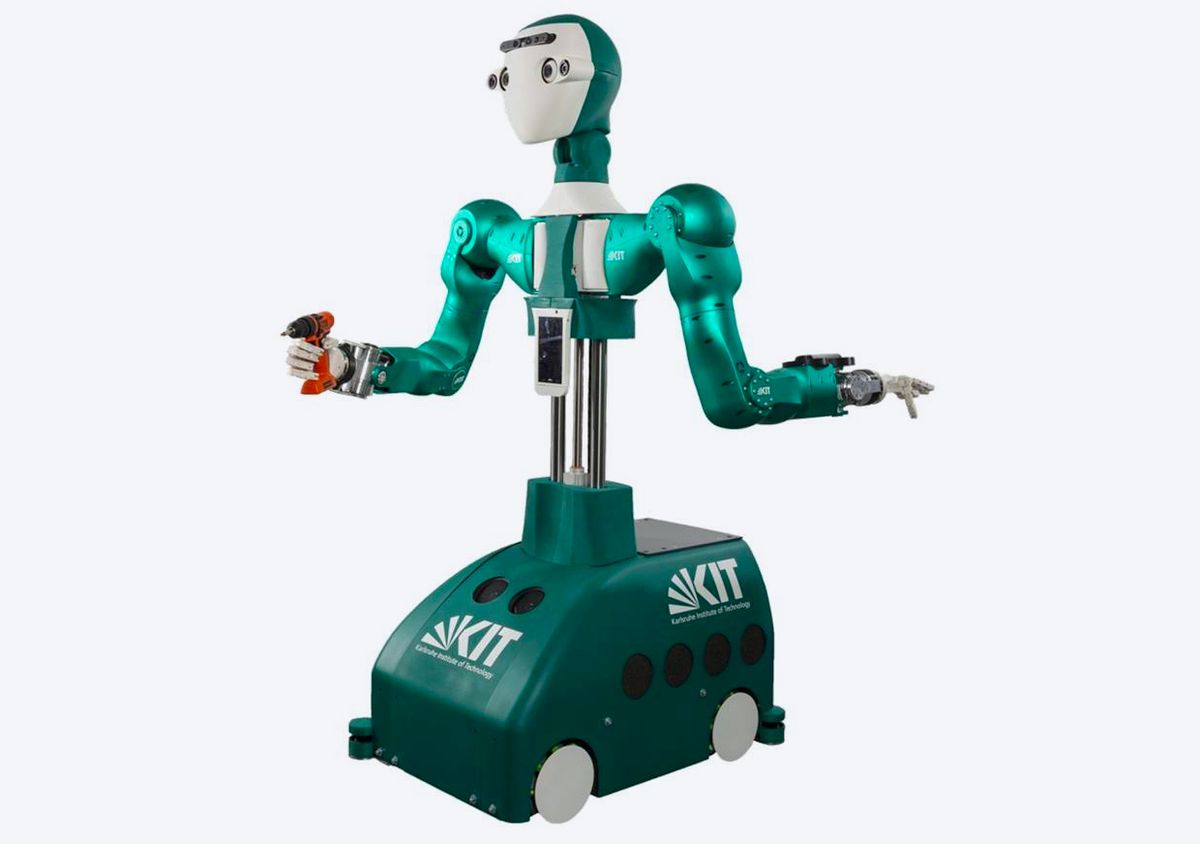While it may be a bit premature to expect collaborative humanoid robots to be doing anything useful in a warehouse environment, the only way we’re going to make it happen is by encouraging the difficult transition between research labs and industry. The European Union is doing a pretty good job of providing support for things like this through its Horizon 2020 program, and one of the projects it’s supporting is called SecondHands, intended to “design a robot that can offer help to a maintenance technician in a pro-active manner… as a second pair of hands that can assist the technician when he/she is in need of help.”
SecondHands is a collaboration between Ocado (a U.K. company that operates highly automated warehouses), Karlsruhe Institute of Technology (which has a bunch of experience building capable humanoid robots), and other research institutions including EPFL, UCL, and Sapienza University of Rome.
Together, they’re using the first prototype of the SecondHands collaborative robot, which also happens to be the sixth version of ARMAR, and one that’s ready (we hope) to do something practical. ARMAR was created by Professor Tamim Asfour and his team at the High Performance Humanoid Technologies Lab (H²T) at KIT’s Institute for Anthropomatics and Robotics.
What Ocado is looking for is a robot that can help a human perform maintenance on the automated systems that make up its warehouses. This is a good place for a robot to start to learn how to be helpful, because it’s a semistructured environment, working with a trained human, doing tasks that are fairly predictable. The robot wouldn’t need to take point on any of these tasks; it would be more of an assistant, trying to cooperate with the human to make them more efficient.
Being able to assist a human like this is challenging, but it’s also a problem that’s relatively well-defined. According to Ocado, “in essence the robot will know what to do, when to do it, and how to do it, in a manner that a human can depend on.”
In the context of a maintenance task, for example, the robot should be able to proactively recognize what’s going on, and understand what exactly the human worker is trying to do. Then it can anticipate critical points at which the human might need assistance, and offer help without being explicitly directed. Rather than waiting for the human to say, “Hey, can you hand me that hammer,” the robot will recognize when the hammer is necessary, and offer it before the human asks.
In addition, the robot will be able to do what robots do best: “augment the humans’ capabilities by completing tasks that require a level of precision or physical strength that are not available to human workers.” And of course it has to do all of these things autonomously and safely around people in an active warehouse.

Making this work effectively requires, among other things, visual scene perception with human action recognition, task planning and execution with continuous monitoring, computer vision techniques for 3D human-pose estimation, human-robot physical interaction with bi-manipulation, and more. All of these areas have been researched robustly in the past, but the cool thing (and the challenging thing) about SecondHands is stuffing them all into one robot that can put them together in a useful way.
The one robot that’s going to have to try and make all of this work is ARMAR-6, the latest generation in KIT’s humanoid robot family. The first ARMAR was built in 1999 (!), and since then, KIT has been improving on it every few years. ARMAR-6 features:
- Two 8-DoF torque-controlled arms with position and torque sensing;
- Two 6-DoF force torque sensors in the wrists;
- Two underactuated 5-finger hands;
- Holonomic mobile base;
- Telescopic torso joint;
- 2-DoF head with two stereo camera systems and an RGB-D sensor;
- Integrated sensor-actuator-controller units.
This is a mostly standard kit for a capable, collaborative mobile robot these days, which means that the magic is going to come primarily from ARMAR’s software. The prototype of the robot presented last week is really just the start: As you can see from the end of the video, ARMAR doesn’t yet seem to have reached the point where it can grasp objects reliably. The SecondHands vision for what the robot will be able to accomplish by 2020 (helping out with real maintenance tasks inside an operating Ocado warehouse) may seem optimistic, but there’s nothing wrong with that—goals like these that involve stretching technology until it breaks have proven to be one of the most effective ways of advancing practical robotics, and they’re definitely some of the most fun to watch.
[ SecondHands ]
Evan Ackerman is a senior editor at IEEE Spectrum. Since 2007, he has written over 6,000 articles on robotics and technology. He has a degree in Martian geology and is excellent at playing bagpipes.



